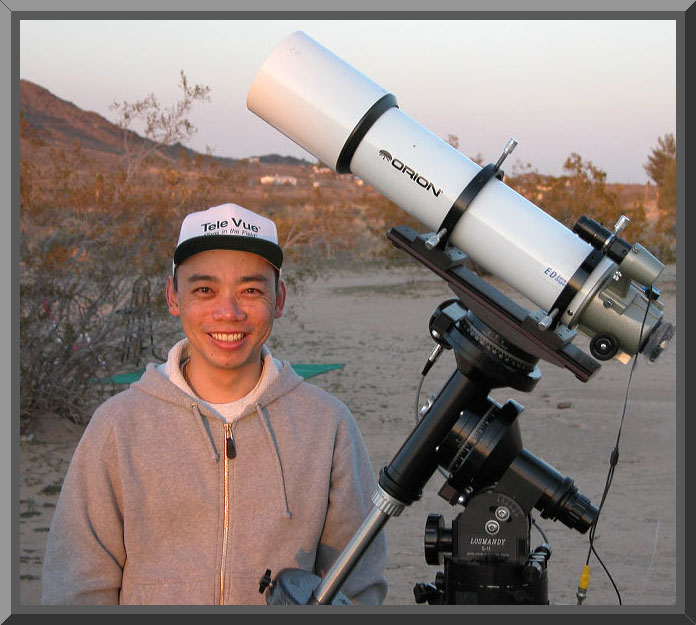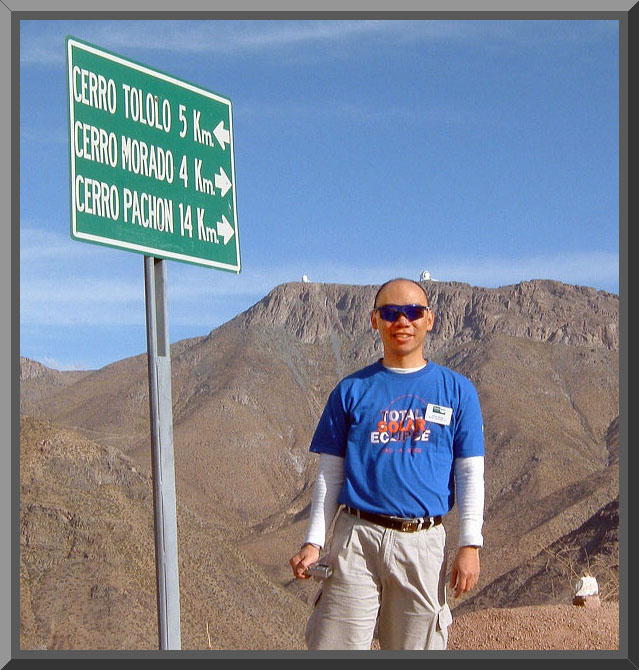|
Michael A. Stecker |
|
Alson Wong, M.D.
Rancho Cucamonga, California U.S.A. |
|
.
My first observing
instrument was a pair of 7x35 Bushnell binoculars which I received as a
gift. The images weren't very sharp and were quite astigmatic, but it was
enough to get me started on objects like the Moon, M31, the Pleiades, and
Hyades. I bought my first telescope, an Edmund Astroscan, during my second
year of college at the University of California, Irvine in 1982-83. This
scope was a nice instrument for learning how to find and observe objects
through a telescope. With the Astroscan, I was able to find and observe
nearly all of the Messier objects.
During the fall quarter of 1983, I took a course at UCI in observational
astronomy taught by Dr. Wallace Tucker, who was then splitting his time
between UCI and the Harvard-Smithsonian Center for Astrophysics. The next
quarter I became a teaching assistant for the course, which gave me
unlimited access to the school's observatory, which contained a C-14, C-8,
and C-5. In 1985 I attended my first big star party, the
Riverside Telescope Makers Conference
near Big Bear, California. After graduating magna cum laude with
a Bachelor of Science in Biological Sciences, I started medical school at
UCI. The time demands of medical school left me little time for observing.
While doing my residency in pediatrics at UCLA Medical Center, I bought my
second telescope, a 10" Coulter Odyssey. My first opportunity to use this
scope under a really dark sky was at the 1991 Texas Star Party, where I
was astounded at how clear and dark the skies were. It was at the 1991 TSP
where Barbara Wilson and Steve O'Meara made the first visual observations
of a gravitational lens through an amateur telescope. I happened to walk
past Barbara's scope just as Steve was stepping down from the ladder, but
I was having so much fun looking through my new scope and through Brian
Skiff's 6" Astro-Physics refractor that I didn't stop to take a look (one
of my biggest astronomical regrets). In
1993 I started my current job with the Southern California Permanente
Medical Group, and in 1995 I saw my first total solar eclipse on a cruise
in the South China Sea. In 1997, as
Comet Hale-Bopp
became increasingly prominent, I started piggyback astrophotography and
began to observe with the Riverside
Astronomical Society, which I joined later that year. In 1998, I began
taking prime focus film shots with my C-9.25, and in 2002 I started CCD
imaging with an ST-10XME. In the past few years I have traveled to solar
eclipses in Turkey
(1999), Zambia (2001),
Australia (2002),
Antarctica (2003),
Egypt (2006),
China (2008,
2009),
French Polynesia (2010)
and Australia 2012. Areas of interest
Sky & Telescope |
|
|
|
Alson traveled to Chile in November 2003
before flying over Antarctica for a solar
eclipse. While in northern Chile he visited three major observatories: the
Very Large
Telescope on Paranal, the Inter-American Observatory on Cerro Tololo, and
the
Gemini South Observatory on Cerro Pachon. He also spent an evening
observing at
Mamalluca Observatory near La Serena, and did some sightseeing in Southern
Chile
including Torres Del Paine National Park. |
|
|

